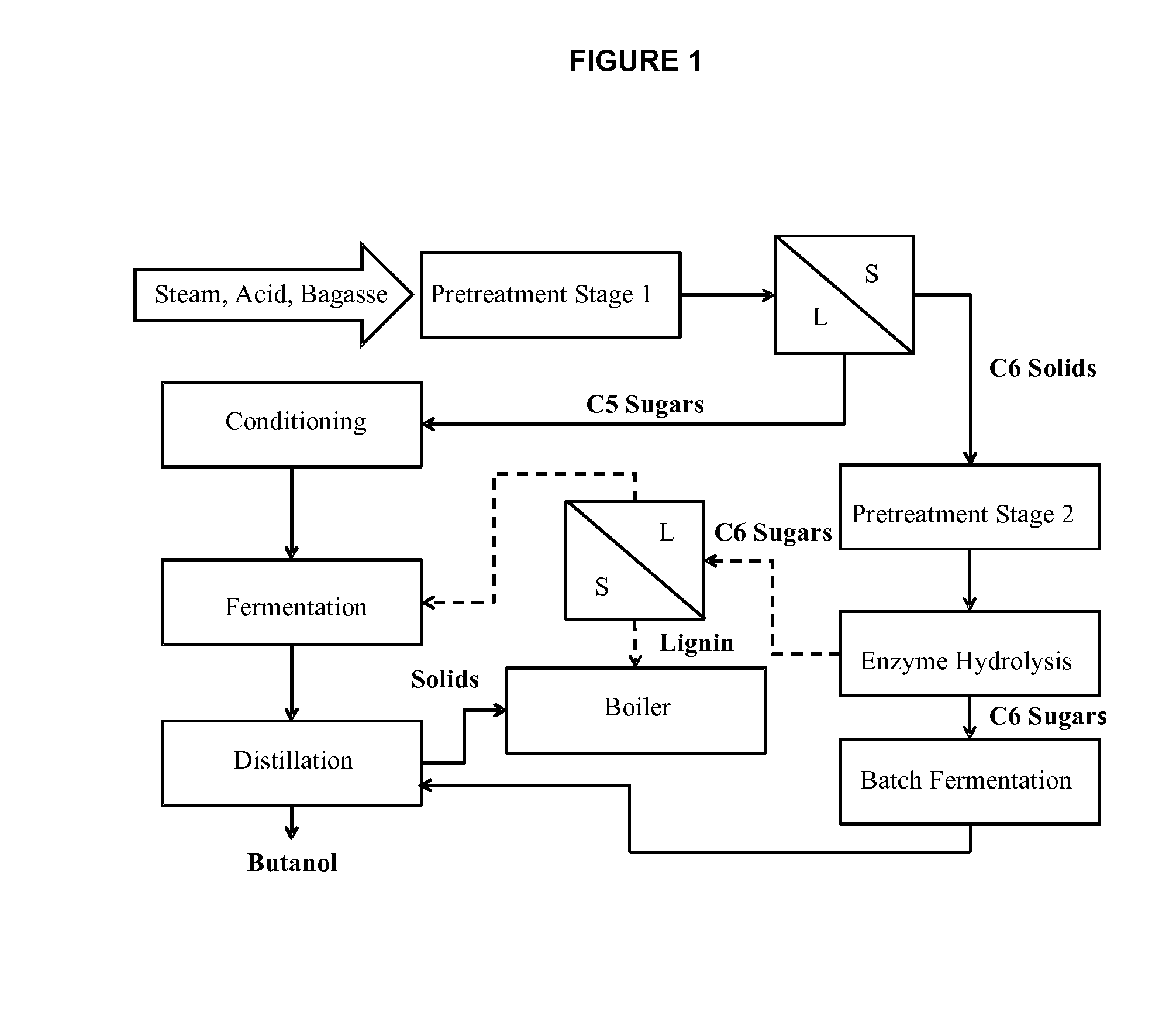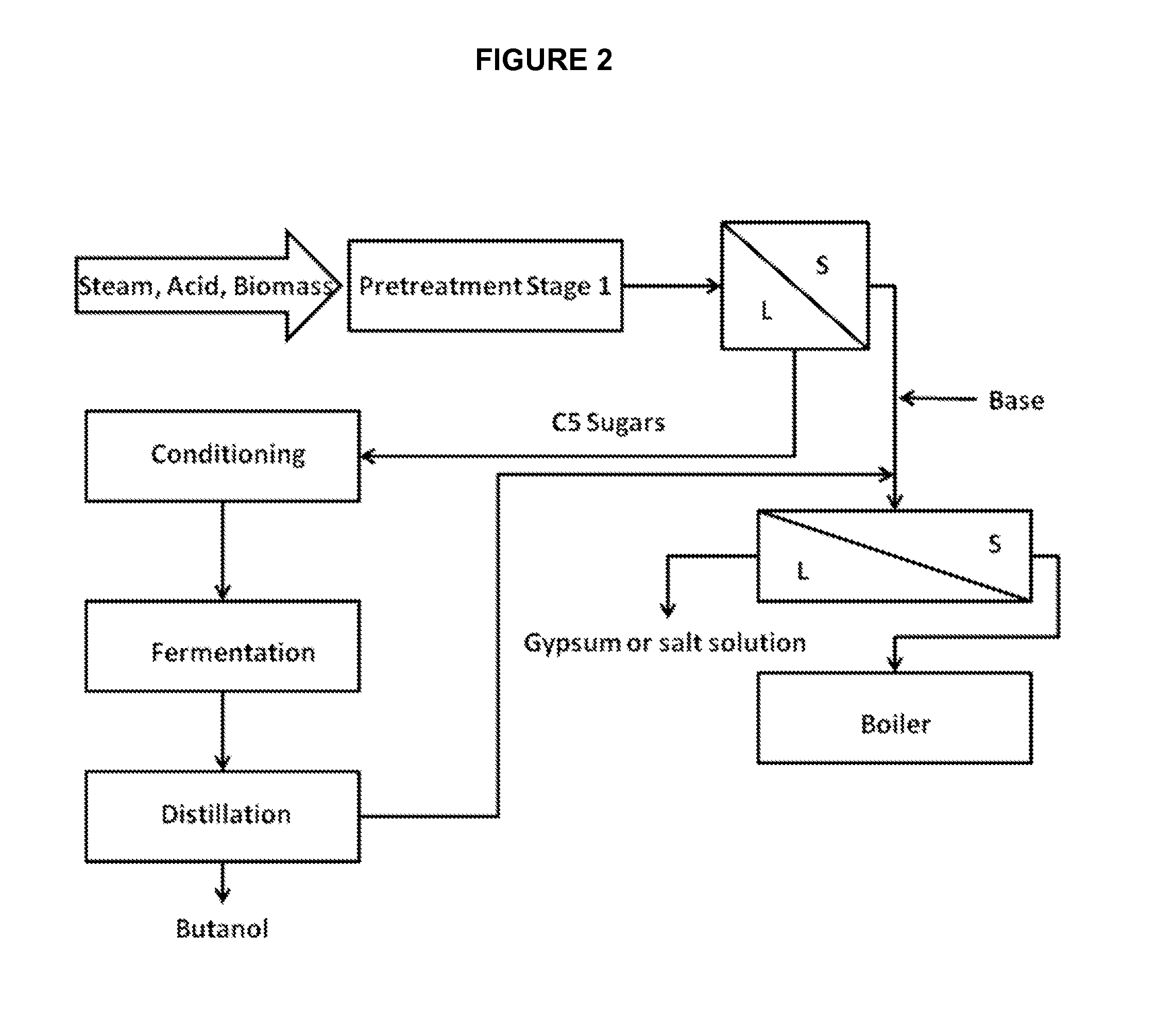Low Severity Pretreatment of Lignocellulosic Biomass
a pretreatment and lignocellulosic technology, applied in the field of low severity pretreatment of lignocellulosic biomass, can solve the problems of limiting the access of a catalyst, such as acid, to the polymeric carbohydrate substrate molecules, and not necessarily doing a good job of recycling solvents for reus
- Summary
- Abstract
- Description
- Claims
- Application Information
AI Technical Summary
Benefits of technology
Problems solved by technology
Method used
Image
Examples
example 1
[0210]Bagasse from two different sources was pretreated with nitric acid for hemicellulose extraction. 85 g of acid was used per kilogram of bagasse, accounting for buffering capacity of the bagasse and the water stream available from city water. A chip refiner (Andritz Fiber Refiner 401) was utilized to mix the acid, water, and bagasse. The plate spacing was set wide open to minimize any milling action on the bagasse while providing sufficient mixing. The machine output was to 55 gallon drums.
[0211]The acid impregnated material was elevated via a barrel lift that carried the drums to a plug screw feeder at the top of the digester. The feeder maintained a plug at its output that held the pressure and temperature of the subsequent plug flow reactor constant. The plug flow reactor temperature was set by adjusting the steam pressure (direct injection of steam) to 25-30 psi (pounds per square inch), providing a reaction temperature of 130° C. The reactor retention time was set to 35 min...
example 2
[0219]Bagasse from Louisiana was used for this experiment. The pretreatment took place in the Parr Reactor model 4524 and Parr Reactor Controller model 4843. The raw bagasse was mixed with nitric acid (68%), glycerol, and water inside of a mixing bag. The acid loading was at 27.2 kg / MT, the glycerol loading was at 23.31 kg / MT, and the solid loading was at 20% dry weight. The total mass of this mixture was at 350 grams. Once the mixture had been thoroughly mixed, the mixture was then loaded into the reaction cylinder of the Parr Reactor.
[0220]After the loading was finished, the reactor cylinder was then assembled with the reactor head. Thermocouple probes were then inserted into the reactor assembly. The reactor assembly was then heated in a heating jacket. By adjusting the temperature from the reactor controller (Parr model 4843), the temperature inside the reaction cylinder can be within +5° C. or −5° C. of the target reaction temperature. The agitator of the Parr Reactor was turne...
example 3
[0222]A hydrolysate recycle experiment was performed in batch mode with sugarcane bagasse as the biomass. A combination of nitric acid and crude glycerol (about 60% by weight) from biodiesel production were used for acid hydrolysis. The reaction components and amounts used for the acid hydrolysis reaction are shown in Table 6.
TABLE 6ReactantMass PercentageBagasse (dry)30.00%Nitric Acid0.816%Glycerol0.554%Balance Water68.63%Total Weight7000 g
[0223]Hydrolysis was performed in a reactor placed in an autoclave set to a temperature of 130° C. for 120 minutes (about 25 psig). The resulting treated biomass was pressed at 700 psi in a 20 ton hydraulic press to separate liquid from solid residue. The liquid was then used as a recycle stream for another cycle of biomass hydrolysis.
[0224]For the next cycle, reactants were replenished back to the concentration levels described in Table 7, and the pH was adjusted to 1.2 with nitric acid. Hydrolysis was then performed in a reactor placed in an au...
PUM
| Property | Measurement | Unit |
|---|---|---|
| temperature | aaaaa | aaaaa |
| temperature | aaaaa | aaaaa |
| temperature | aaaaa | aaaaa |
Abstract
Description
Claims
Application Information
 Login to View More
Login to View More - R&D
- Intellectual Property
- Life Sciences
- Materials
- Tech Scout
- Unparalleled Data Quality
- Higher Quality Content
- 60% Fewer Hallucinations
Browse by: Latest US Patents, China's latest patents, Technical Efficacy Thesaurus, Application Domain, Technology Topic, Popular Technical Reports.
© 2025 PatSnap. All rights reserved.Legal|Privacy policy|Modern Slavery Act Transparency Statement|Sitemap|About US| Contact US: help@patsnap.com


